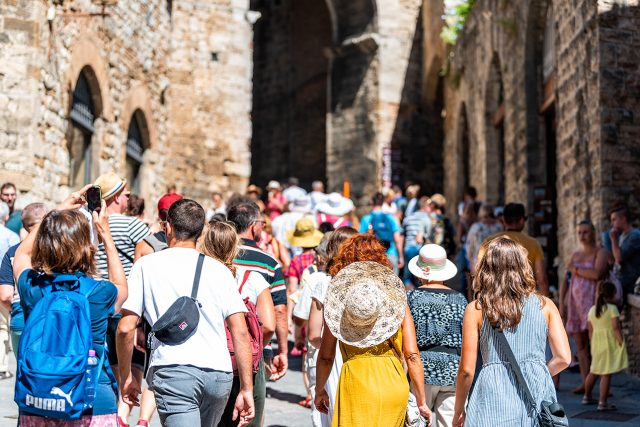
Rome leads, coastal towns surge, and foreign visitors dominate—ISTAT data reveals the geography of Italian tourism
In recent weeks, tourism has become a hot topic in Italian politics. Opposition figures claim that many Italians can no longer afford a vacation, while members of Giorgia Meloni’s government boast of record-breaking arrivals. Trade associations, for their part, have reported a dip in beach and hotel stays. With official data from the current season still incomplete, much of the debate rests on perception. But the 2024 statistics from ISTAT offer a clearer picture of where tourists go, how long they stay, and the weight that tourism exerts on local communities.
A Country of Concentrated Tourism
Italy welcomed 139 million tourist arrivals in 2024, generating 466 million overnight stays. These numbers, however, are far from evenly distributed.
Rome alone accounted for 9.2% of all overnight stays, confirming its role as Italy’s undisputed magnet for international travellers. Milan (3%) and Venice (2.8%) followed at a distance, while Florence, Rimini, and a cluster of seaside towns in the province of Venice—Cavallino-Treporti, San Michele al Tagliamento, and Jesolo—rounded out the top tier.
Taken together, the top ten municipalities attracted a quarter of all tourism, even though they represent just 9% of Italy’s population. The top 100 municipalities hosted 53% of overnight stays, underscoring the extreme concentration of tourism in a relatively small part of the country.
Beyond the big cities, major flows were also directed toward South Tyrol (Bolzano and Trento provinces), the Tuscan countryside, Emilia-Romagna’s coast, Puglia, sections of Sicily, and the Aosta Valley.
How Long Tourists Stay
The average length of stay across Italy in 2024 was 3.4 nights, but patterns varied dramatically.
Coastal resorts: around a week.
Mountain destinations like Trentino-Alto Adige and parts of Tuscany: between 3 and 6 nights.
Puglia: about 3 days.
Cities: shorter stays, with Rome averaging 4.2 nights, Venice and Florence 2.3, Milan and Bologna 2.2.
Outliers illustrate the diversity of Italy’s tourism economy. Pieve Emanuele, near Milan, recorded an astonishing 24-night average stay, reflecting long-term bookings tied to specific facilities. On the opposite extreme, Parma, Bergamo, and Matera reported stays of less than two nights, highlighting their role as quick stopovers.
Foreign Visitors Drive the Market
Italy’s appeal to international travellers remains strong. Foreign tourists accounted for 55% of overnight stays in 2024. In some provinces and cities, their dominance is overwhelming:
Rome: 73% foreign
Venice: 87% foreign
Florence: 83% foreign
Milan: 74% foreign
Naples: 58% foreign
Among Italy’s major urban centres, only Turin remained majority Italian, with foreigners at just 42%.
Interestingly, the opposite pattern exists in certain regions. In towns across South Tyrol—such as Caldaro, Tirolo, Lana, and Scena—over 94% of stays were made by Italians. Other domestic strongholds include Sorrento on the Amalfi Coast and Garda in Veneto, both with over 90% Italian visitors.
Tourism Pressure: When Visitors Outnumber Locals
The intensity of tourism—the ratio of overnight stays to residents—reveals the real strain on local infrastructure. Nationally, Italy registered 8 overnight stays per resident in 2024, but local differences are striking.
In Trentino-Alto Adige, some mountain towns reached 500 stays per inhabitant. The record belongs to Limone sul Garda, where 1.2 million overnight stays were recorded against just 1,110 residents—a staggering ratio of 1,097 to 1.
Among larger municipalities, Venice leads with 53 overnight stays per resident, followed by Rimini (46), Florence (26), and Fiumicino (25). By contrast, Rome (16), Milan (10), Naples (4.2), and Turin (4.2) experience a far lower ratio relative to their size, though the absolute numbers remain immense.
Beyond Politics: What the Numbers Mean
The debate in Rome may focus on who can afford holidays and whether the government can claim “record tourism,” but the underlying data suggest a more nuanced picture. Italy is not uniformly crowded with tourists: a handful of cities and resorts bear the brunt, while vast areas of the country see far lighter flows.
The growing intensity of tourism, particularly in fragile historic centers and small mountain villages, raises concerns about sustainability. Meanwhile, the dominance of foreign visitors in urban hubs reinforces Italy’s dependence on international travel trends, making the sector vulnerable to global shocks.
As ISTAT prepares to release updated figures for 2025, policymakers will face familiar questions: How can Italy spread tourism more evenly across its territory? How can local communities balance economic benefits with quality of life? And most importantly, how can one of the country’s most vital industries remain both competitive and sustainable in the long run?



 Subscribe
Subscribe